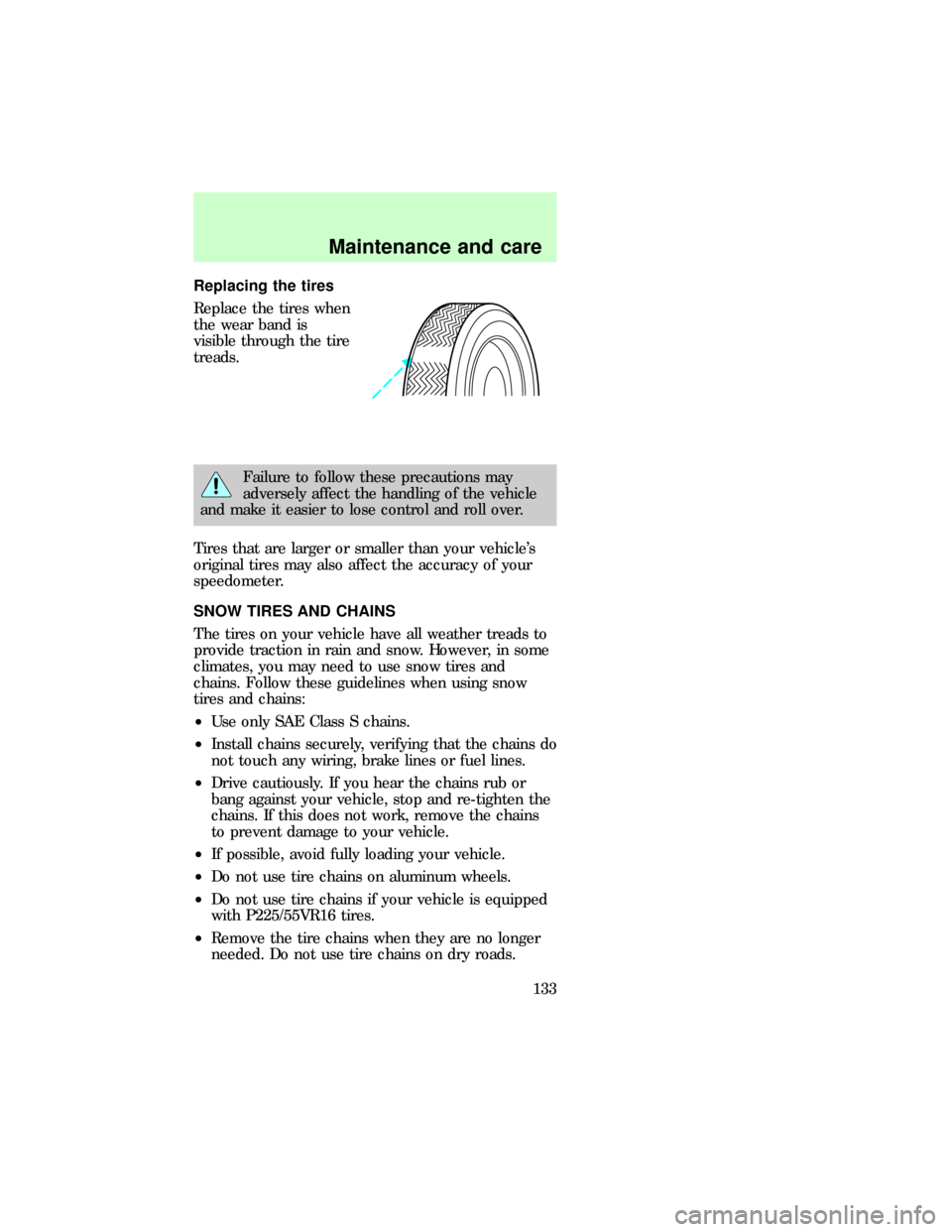wheel Mercury Sable 1997 s Owner's Guide
[x] Cancel search | Manufacturer: MERCURY, Model Year: 1997, Model line: Sable, Model: Mercury Sable 1997Pages: 167, PDF Size: 1.59 MB
Page 131 of 167

one and one-half (1 1/2) times as well on the
government course as a tire grade 100. The relative
performance of tires depends upon the actual
conditions of their use, however, and may depart
significantly from the norm due to variations in
driving habits, service practices, and differences in
road characteristics and climate.
Traction A B C
The traction grades, from highest to lowest are A, B,
and C, and they represent the tire's ability to stop
on wet pavement as measured under test surfaces of
asphalt and concrete. A tire marked C may have
poor traction performance. Warning: The traction
grade assigned to this tire is based on braking
(straightahead) traction tests and does not include
cornering (turning) traction.
Temperature A B C
The temperature grades are A (the highest), B, and
C, representing the tire's resistance to the
generation of heat and its ability to dissipate heat
when tested under controlled conditions on a
specified indoor laboratory test wheel. Sustained
high temperature can cause the material of the tire
to degenerate and reduce tire life, and excessive
temperature can lead to sudden tire failure. The
grade C corresponds to a level of performance which
all passenger car tires must meet under the Federal
Motor Vehicle Safety Standard No. 109. Grades B
and A represent higher levels of performance on the
laboratory test wheel than the minimum required by
law.
com_traction_abc.01
com_temperature_abc.01
Maintenance and care
131
Page 133 of 167

Replacing the tires
Replace the tires when
the wear band is
visible through the tire
treads.
Failure to follow these precautions may
adversely affect the handling of the vehicle
and make it easier to lose control and roll over.
Tires that are larger or smaller than your vehicle's
original tires may also affect the accuracy of your
speedometer.
SNOW TIRES AND CHAINS
The tires on your vehicle have all weather treads to
provide traction in rain and snow. However, in some
climates, you may need to use snow tires and
chains. Follow these guidelines when using snow
tires and chains:
²Use only SAE Class S chains.
²Install chains securely, verifying that the chains do
not touch any wiring, brake lines or fuel lines.
²Drive cautiously. If you hear the chains rub or
bang against your vehicle, stop and re-tighten the
chains. If this does not work, remove the chains
to prevent damage to your vehicle.
²If possible, avoid fully loading your vehicle.
²Do not use tire chains on aluminum wheels.
²Do not use tire chains if your vehicle is equipped
with P225/55VR16 tires.
²Remove the tire chains when they are no longer
needed. Do not use tire chains on dry roads.
dno_snow-tires-and-chains
Maintenance and care
133
Page 147 of 167

exterior accessories, such as antennas, before
entering a car wash.
²After washing, apply the brakes several times to
dry them.
Waxing your vehicle
The best way to determine when the paintwork
needs waxing is by noting when water stops beading
on the surface. This could be every three or four
months, depending on operating conditions.
Use only carnauba or synthetic-based waxes.
Remove any bugs and tar before waxing vehicle. Use
cleaning fluid or alcohol with a clean cloth to
remove. Use tar remover to remove any tar spots.
Repairing paint chips
Minor scratches or paint damage from road debris
may be repaired with touch-up paint, paint repair
foil or aerosol paint spray from the Ford accessory
line. Observe the application instructions on the
products.
Remove particles such as bird droppings, tree sap,
insect remains, tar spots, road salt and industrial
fallout immediately.
Cleaning the wheels
Wash the wheels with
the same detergent you
use to clean the body
of your vehicle. Do not
use acid-based wheel cleaners, steel wool, fuel or
strong detergents. Never use abrasives that will
damage the finish of special wheel surfaces. Use a
tar remover to remove grease and tar.
Cleaning the engine
Engines are more efficient when they are clean
because grease and dirt buildup act as insulators and
keep the engine warmer than normal. Follow these
guidelines to clean your engine:
com_waxing_vehicle.01
com_repairing_chips
com_wheels_cleaning.01
com_engine_cleaning.01
Maintenance and care
147
Page 156 of 167

Engine data
Spark plug gap 1.07-1.17 mm
(0.042-0.046
inch)1.07-1.17 mm
(0.042-0.046
inch)
Ignition system DIS DIS
Valve clearance
cold inlet
exhaust0: Maintenance
free0: Maintenance
free
VEHICLE DIMENSIONS
Vehicle
dimensions
mm (in.)Sedan Wagon
(1) Overall
length5016.5 (197.5) 5069.8 (199.6)
(2) Overall
width1854.2 (73.0) 1854.2 (73.0)
(3) Overall
height1399.5 (55.1) 1463.0 (57.6)
(4) Wheelbase 2755.9 (108.5) 2755.9 (108.5)
(5) Track -
Front1564.6 (61.6) 1564.6 (61.6)
(5) Track -
Rear1559.6 (61.4) 1569.7 (61.8)
dno_vehicle-dimensions
Capacities and specifications
156
Page 163 of 167

Aiming headlamps .. 144
Air bag supplemental
restraint system
and child safety
seats ......................... 61
description .............. 60
disposal .................... 64
indicator light ......... 63
passenger air bag ... 62
Air cleaner filter
replacing ................ 129
Air conditioning
automatic temperature
control system 16,17,18,
19,20
manual heating and air
conditioning
system ........... 14,15,16
Anti-theft system ...... 44
warning light ............. 8
Audio system (see
Electronic sound
system) ...................... 21
Autolamp system (see
Headlamps) ............... 13
Battery ..................... 127
servicing ................ 128
Brakes
adjustment .............. 81
anti-lock ................... 81
fluid, checking and
adding .................... 120
Brake-shift interlock . 83
Break-in period ........... 2
Cargo cover ............... 35
Cargo net ................... 35
Child safety seats ...... 66
Childproof locks ........ 31
Cleaning your vehicle 146
built-in child seat . 150engine
compartment ......... 147
fabric ...................... 149
instrument panel .. 149
plastic parts .......... 148
safety belts ............ 150
tail lamps ............... 148
washing .................. 146
waxing ................... 147
wheels .................... 147
Climate control
system ........................ 14
Console, description . 31
Daytime running light
system ........................ 14
Emission control
system ...................... 137
Engine
service points . 116,117
Engine block heater . 79
Engine coolant
checking and
adding ............. 121,122
disposal .................. 123
refill capacities ...... 124
Engine oil ................ 119
changing oil and oil
filter ....................... 119
checking and
adding .................... 118
Entry system
illumination ............. 43
Exhaust fumes .......... 79
Floor mats ................. 33
Fuel
calculating fuel
economy ................ 137
improving fuel
economy .................. 95
octane rating ......... 136
Index
163
Page 165 of 167

arming and disarming
the anti-theft
system ..................... 42
locking/unlocking
doors ................... 41,42
opening the trunk ... 41
panic alarm ............. 42
replacement/additional
transmitters ............. 43
replacing the
batteries .................. 43
Reporting safety
defects ..................... 162
Safety restraints
automatic locking
mode (retractor) 53,54
center rear lap belt 55
extension assembly 58
for children ............. 64
for second row bench
seats ............... 71,72,74
lap and shoulder
belts ......................... 52
maintenance ............ 60
proper use ............... 52
warning light and
chime ....................... 59
Safety seats for children
attaching with tether
straps .................. 69,70
automatic locking
mode (retractor) .... 67
tether anchorage
hardware ................. 70
Seats
adjusting the seat,
manual ..................... 48
adjusting the seat,
power ....................... 49
folding rear seats .... 50
head restraints ........ 48Servicing your
vehicle ...................... 114
precautions when
servicing ................ 114
Spare tire ................. 105
Speed control ............ 22
Speedometer ............. 10
Starting your vehicle 77
preparing to start your
vehicle ..................... 76
starting a warm
engine ...................... 78
Storage
compartments ........... 35
Tachometer
mechanical cluster . 11
Tilt steering wheel .... 27
Tires ......................... 132
changing ................ 106
checking the
pressure ................. 132
replacing ................ 133
rotating .................. 132
snow tires and
chains .................... 133
tire grades ............. 130
treadwear .............. 130
Towing your vehicle 113
Trailer towing ............ 91
tips ........................... 94
Transaxle ................... 83
automatic
operation ...... 84,85,86,
87,88,89
fluid, checking and
adding
(automatic) ... 125,126,
127
Trip odometer ........... 12
Trunk
using the remote entry
system to open ....... 34
Turn signal ................ 25
Index
165
Page 166 of 167

indicator lights .......... 6
Vehicle dimensions . 156
Vehicle loading .......... 89
Ventilating your
vehicle ........................ 80
Warning chimes
headlamps on ............ 9
key in ignition ......... 10
safety belt ............... 10
Washer fluid ............ 121
rear window
reservoir ................ 121Wheels
anti-theft lug nuts 109
covers .................... 108
Windows
power windows,
operating ................. 29
Windshield washer fluid
and wipers ............ 21,26
checking and replacing
wiper blades .......... 129
Wrecker towing ....... 112
Index
166